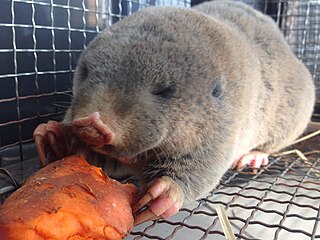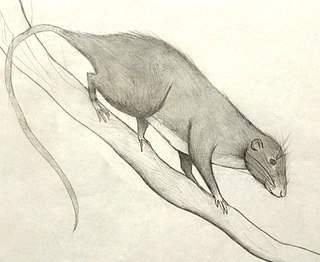Mole-rat or mole rat can refer to several groups of burrowing Old World rodents:

The Muroidea are a large superfamily of rodents, including mice, rats, voles, hamsters, lemmings, gerbils, and many other relatives. Although the Muroidea originated in Eurasia, they occupy a vast variety of habitats on every continent except Antarctica. Some authorities have placed all members of this group into a single family, Muridae, due to difficulties in determining how the subfamilies are related to one another. Many of the families within the Muroidea superfamily have more variations between the families than between the different clades. A possible explanation for the variations in rodents is because of the location of these rodents; these changes could have been due to radiation or the overall environment they migrated to or originated in. The following taxonomy is based on recent well-supported molecular phylogenies.

Zokors are Asiatic burrowing rodents resembling mole-rats. They include two genera: Myospalax and Eospalax. Zokors are native to much of China, Kazakhstan, and Siberian Russia.

The Muridae, or murids, are the largest family of rodents and of mammals, containing approximately 1,383 species, including many species of mice, rats, and gerbils found naturally throughout Eurasia, Africa, and Australia.

The Cricetidae are a family of rodents in the large and complex superfamily Muroidea. It includes true hamsters, voles, lemmings, muskrats, and New World rats and mice. At almost 608 species, it is the second-largest family of mammals, and has members throughout the Americas, Europe and Asia.

The Spalacidae, or spalacids, are a family of rodents in the large and complex superfamily Muroidea. They are native to eastern Asia, the Horn of Africa, the Middle East, and southeastern Europe. It includes the blind mole-rats, bamboo rats, mole-rats, and zokors. This family represents the oldest split in the muroid superfamily, and comprises animals adapted to a subterranean way of life. These rodents were thought to have evolved adaptations to living underground independently until recent genetic studies demonstrated they form a monophyletic group. Members of the Spalacidae are often placed in the family Muridae along with all other members of the Muroidea.

The Eumuroida are a clade defined in 2004 by Steppan et al. that includes rats, mice and related species, though not all rodents; in other words, a specific group of muroid rodents. The clade is not defined in the standard taxonomic hierarchy, but it is between superfamily and family.

The blind mole-rats, also known as the fossorial or subterranean mole rats, are a subfamily (Spalacinae) of rodents in the family Spalacidae, found in eastern Europe and western & central Asia. The hystricognath mole-rats of the family Bathyergidae are completely unrelated, but some other forms are also in the family Spalacidae. Zokors, root rats, and bamboo rats are spalacids also sometimes referred to as mole rats.

The Malagasy rodents are the sole members of the subfamily Nesomyinae. These animals are the only native rodents of Madagascar, come in many shapes and sizes, and occupy a wide variety of ecological niches. There are nesomyines that resemble gerbils, rats, mice, voles, and even rabbits. There are arboreal, terrestrial, and semi-fossorial varieties.

The Old World rats and mice, part of the subfamily Murinae in the family Muridae, comprise at least 519 species. Members of this subfamily are called murines. In terms of species richness, this subfamily is larger than all mammal families except the Cricetidae and Muridae, and is larger than all mammal orders except the bats and the remainder of the rodents.

The blesmols, also known as mole-rats, or African mole-rats, are burrowing rodents of the family Bathyergidae. They represent a distinct evolution of a subterranean life among rodents much like the pocket gophers of North America, the tuco-tucos in South America, or the Spalacidae from Eurasia.

Dactylomys is the genus of South American bamboo rats They are arboreal members of the family Echimyidae.

Olallamys is a genus of Andean soft-furred spiny rat that range from Panama through Colombia and Venezuela to northern Ecuador. These species are typically found at elevations above 2,000 metres (6,600 ft).

The Middle East blind mole-rat or Palestine mole-rat is a species of rodent in the family Spalacidae.

Nannospalax is a genus of rodent in the family Spalacidae, found in eastern Europe and western Asia. It is one of two genera in the blind mole-rats, alongside Spalax. Members of this genus are also known as small-bodied mole-rats. As with members of the genus Spalax, they are completely blind, with their eyes being entirely covered by skin.

The lesser blind mole-rat is a species of rodent in the family Spalacidae. It is found in Albania, Bosnia and Herzegovina, Bulgaria, Croatia, Greece, Hungary, North Macedonia, Moldova, Romania, Serbia, Montenegro, Turkey and Ukraine.
Makalata is a genus of rodents in the family Echimyidae.
The Bukovina blind mole-rat or (erroneously) the Balkan blind mole-rat is a species of rodent in the family Spalacidae found in Romania, Moldova, and Ukraine.
Mehely's blind mole-rat is an endangered species of rodent in the family Spalacidae. It is endemic to Romania.
The Oltenia blind mole-rat is a critically endangered, possibly extinct species of rodent in the family Spalacidae. It is endemic to Romania.











